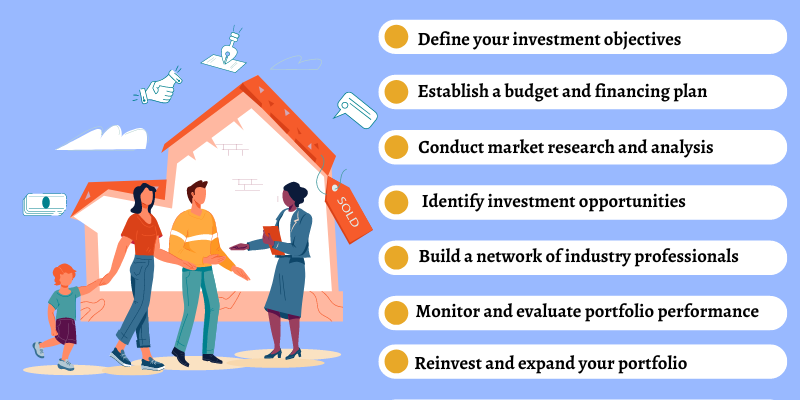A real estate portfolio is a collection of properties that can generate passive income and provide long-term wealth and financial security. Building a real estate portfolio can be lucrative whether you’re a seasoned investor or just starting out.
This comprehensive guide emphasizes how to build a real estate portfolio. We’ll explore various investment strategies, including residential and commercial properties, fix-and-flip projects, rental properties, and real estate investment trusts (REITs).
We’ll discuss the benefits of leveraging financing options, conducting thorough market research, and evaluating potential properties based on their potential for cash flow, appreciation, and ROI.
Additionally, we’ll provide practical networking tips, find reliable real estate professionals, and conduct due diligence when acquiring properties.
We’ll also highlight the importance of monitoring and managing your portfolio to ensure its continued growth and success.
By following our expert advice and implementing proven strategies, you can build a real estate portfolio that generates passive income and creates wealth over time.
Whether you’re looking to secure your financial future, diversify your investment portfolio, or generate additional income streams, our guide will equip you with the knowledge and confidence to navigate the real estate market and make informed investment decisions.
So, are you ready to embark on an exciting journey toward building a real estate portfolio?
Join us in our blog post and discover how you can harness the power of real estate investments to achieve your financial goals and create a brighter future for yourself and your family.
7 Steps on How to Build a Real Estate Portfolio
This blog will explore the seven essential steps to build a real estate portfolio successfully. These steps include:
- Define your investment objectives
- Establish a budget and financing plan
- Conduct market research and analysis
- Identify investment opportunities
- Build a network of industry professionals
- Monitor and evaluate portfolio performance
- Reinvest and expand your portfolio
By following these seven steps, you can confidently navigate the process of building a real estate portfolio and set yourself on the path to long-term financial success.
1. Define Your Investment Objectives
Defining your investment objectives is crucial to building a successful real estate portfolio. Determine your financial goals and objectives, whether it’s generating cash flow or capital appreciation.
Identify your preferred investment strategy, such as long-term rentals, fix-and-flip, or commercial properties.
Consider your risk tolerance and investment timeline to align your portfolio with your specific needs and preferences.
2. Establish a Budget and Financing Plan
Creating a budget and financing plan is essential for effective real estate investing. Determine your budget, including the amount you can allocate for down payments, closing costs, and ongoing expenses.
Explore financing options such as mortgages, loans, or partnerships to secure the necessary funding for your investments.
Carefully evaluate different financing options to find the most suitable one for your financial situation.
3. Conduct Market Research and Analysis
Thorough market research and analysis are vital to identifying lucrative investment opportunities. Research and identify target real estate markets and locations that align with your investment objectives.
Analyze market trends, property values, and rental demand in those areas. Evaluate economic indicators and growth potential to ensure you invest in markets with strong appreciation and rental income prospects.
4. Identify Investment Opportunities
Identifying the right investment opportunities is crucial for building a real estate portfolio. Determine the type of properties you want to invest in, such as residential, commercial, or multi-family properties.
Conduct due diligence on potential investment properties, including thorough property inspections and analysis of their rental potential.
Consider factors such as location, market demand, and potential return on investment (ROI) to make informed investment decisions.
5. Build a Network of Industry Professionals
Building a network of industry professionals is invaluable for real estate investors. Connect with real estate agents, brokers, property managers, contractors, inspectors, and other professionals in the industry.
Establish relationships with these individuals to gain insights, guidance, and access to off-market deals.
Seek guidance from experienced real estate investors or consider joining investment clubs or associations to expand your network further.
6. Monitor and Evaluate Portfolio Performance
Regularly monitoring and evaluating the performance of your real estate portfolio is crucial for long-term success.
Track the financial performance of each property, including cash flow, occupancy rates, and property appreciation.
Conduct regular property inspections and make necessary adjustments to improve performance, such as property upgrades or adjustments in rental rates.
Stay proactive in managing your portfolio to maximize returns and mitigate risks.
7. Reinvest and Expand Your Portfolio
Reinvesting profits and expanding your real estate portfolio is vital to long-term wealth building.
Allocate profits from successful investments to acquire additional properties or upgrade existing ones.
Review and optimize your portfolio based on changing market conditions and investment goals.
Stay updated on market trends and seize opportunities for portfolio expansion to grow your real estate wealth.
Conclusion
Building a real estate portfolio can be rewarding and offer long-term financial benefits. By following the seven essential steps on how to build a real estate portfolio outlined in this blog, you can lay a solid foundation for success in real estate investing.
Defining your investment objectives and establishing a budget and financing plan will help you align your portfolio with your financial goals.
Conducting thorough market research and analysis will enable you to identify lucrative investment opportunities in promising real estate markets.
Building a network of industry professionals and continuously monitoring and evaluating your portfolio’s performance will ensure you stay informed and proactive in managing your investments.
Lastly, reinvesting profits and expanding your portfolio will contribute to the growth of your real estate wealth over time.
To embark on this exciting journey, seeking professional guidance and training courses from ThinkProp is essential.
ThinkProp’s real estate training programs offer comprehensive education and expert insights that can enhance your knowledge and skills in real estate investing.
Our experienced instructors and practical approach to learning can provide you with the necessary tools and strategies to navigate the complexities of the real estate market.
Don’t wait any longer – take action today and start building your real estate portfolio.
Real estate offers exciting opportunities with lucrative salaries, so start your journey to becoming a licensed real estate professional today!
Explore the opportunities available, seize the moment, and pave your way to a prosperous future in the real estate industry.








